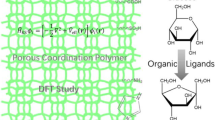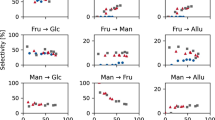Abstract
The mechanisms and energetics for Brønsted acid-catalyzed glucose condensation, dehydration and isomerization reactions were discussed based on our earlier CPMD–MTD simulation results. Glucose condensation reaction is initiated by the protonation of C1–OH, whereas both dehydration and isomerization reactions are initiated by the protonation of C2–OH to form a common 5-member ring intermediate. Glucose dehydration to form HMF occurs via the direct cyclic mechanism, rather than via the open chain mechanism converting glucose to fructose then to HMF. Fructose is formed via a 1,2 hydride shift process following the formation of 5-member ring intermediate. The barriers for Brønsted acid-catalyzed glucose reactions are largely solvent induced due to the competition for proton from the solvent molecules.








Similar content being viewed by others
References
Chheda JN, Roman-Leshkov Y, Dumesic JA (2007) Production of 5-hydroxymethylfurfural and furfural by dehydration of biomass-derived mono- and poly-saccharides. Green Chem 9:342–350
Corma A, Iborra S, Velty A (2007) Chemical routes for the transformation of biomass into chemicals. Chem Rev 107:2411–2502
Bicker M, Hirth J, Vogel H (2003) Dehydration of fructose to 5-hydroxymethylfurfural in sub- and supercritical acetone. Green Chem 5:280–284
Chheda JN, Huber GW, Dumesic JA (2007) Liquid-phase catalytic processing of biomass-derived oxygenated hydrocarbons to fuels and chemicals. Angew Chem Int Ed 46:7164–7183
Chheda JN, Dumesic JA (2007) An overview of dehydration, aldol-condensation and hydrogenation processes for production of liquid alkanes from biomass-derived carbohydrates. Catal Today 123:59–70
Zhao HB, Holladay JE, Brown H, Zhang ZC (2007) Metal chlorides in ionic liquid solvents convert sugars to 5-hydroxymethylfurfural. Science 316:1597–1600
van Damm HE, Kieboom APG, van Bekkum H (1986) The conversion of fructose and glucose in acidic media: formation of hydroxymethylfurfural. Starch 38:95–101
Szmant HH, Chundury DD (1981) The preparation of 5-hydroxymethylfurfuraldehyde from high fructose corn syrup and other carbohydrates. J Chem Technol Biotechnol 31:135–145
Seri K, Inoue Y, Ishida H (2001) Catalytic activity of Lanthanide(III) ions for the dehydration of hexose to 5-hydroxymethyl-2-furaldehyde in water. Bull Chem Soc Jpn 74:1145–1150
Kuster BFM (1990) 5-Hydroxymethylfurfural (HMF). A Review focussing on its manufacture. Starch 42:314–321
Chheda JN, Barrett CJ, Huber GW, Dumesic JA (2006) Production of large, water-soluble intermediates from carbohydrate-derived compounds by sequential condensation/hydrogenation. Abs Pap Am Chem Soc 231:1
Liu DJ, Nimlos MR, Johnson DK, Himmel ME, Qian XH (2010) Free energy landscape for glucose condensation reactions. J Phys Chem A 114:12936–12944
Qian XH (2011) Mechanisms and energetics for acid catalyzed beta-d-glucose conversion to 5-hydroxymethylfurfurl. J Phys Chem A 115:11740–11748
Qian XH, Nimlos MR, Johnson DK, Himmel ME (2005) Acidic sugar degradation pathways. Appl Biochem Biotechnol 121:989–997
Qian XH, Nimlos MR, Davis M, Johnson DK, Himmel ME (2005) Ab initio molecular dynamics simulations of beta-d-glucose and beta-d-xylose degradation mechanisms in acidic aqueous solution. Carbohydr Res 340:2319–2327
Qian X, Nimlos MR (2008) Mechanisms of xylose and xylooligomer degradation during acid pretreatment. In: Himmel M (ed) Biomass recalcitrance. Blackwell Publishing Ltd, Oxford
Dong H, Nimlos MR, Himmel ME, Johnson DK, Qian X (2009) The effects of water on β-d-xylose condensation reactions. J Phys Chem A 113:8577–8585
Qian XH, Johnson DK, Himmel ME, Nimlos MR (2010) The role of hydrogen-bonding interactions in acidic sugar reaction pathways. Carbohydr Res 345:1945–1951
Yong G, Zhang YG, Ying JY (2008) Efficient catalytic system for the selective production of 5-hhydroxymethylfurfural from glucose and fructose. Angew Chem Int Ed 47:9345–9348
Binder JB, Raines RT (2009) Simple chemical transformation of lignocellulosic biomass into furans for fuels and chemicals. J Am Chem Soc 131:1979–1985
Li CZ, Zhang ZH, Zhao ZBK (2009) Direct conversion of glucose and cellulose to 5-hydroxymethylfurfural in ionic liquid under microwave irradiation. Tetrahedron Lett 50:5403–5405
Hu SQ, Zhang ZF, Song JL, Zhou YX, Han BX (2009) Efficient conversion of glucose into 5-hydroxymethylfurfural catalyzed by a common Lewis acid SnCl(4) in an ionic liquid. Green Chem 11:1746–1749
Kim B, Jeong J, Lee D, Kim S, Yoon H-J, Lee Y-S, Cho JK (2011) Direct transformation of cellulose into 5-hydroxymethyl-2-furfural using a combination of metal chlorides in imidazolium ionic liquid. Green Chem 13:1503–1506
Zhang YT, Du HB, Qian XH, Chen EYX (2010) Ionic liquid-water mixtures: enhanced K-w for efficient cellulosic biomass conversion. Energy Fuels 24:2410–2417
Moliner M, Roman-Leshkov Y, Davis ME (2010) Tin-containing zeolites are highly active catalysts for the isomerization of glucose in water. Proc Natl Acad Sci USA 107:6164–6168
Car R, Parrinello M (1985) Unified approach for molecular dynamics and density-functional theory. Phys Rev Lett 55:2471–2474
Iannuzzi M, Laio A, Parrinello M (2003) Efficient exploration of reactive potential energy surfaces using car-parrinello molecular dynamics. Phys Rev Lett 90:238302
Dong H, Qian X (2011) Ab initio molecular dynamics investigation of xylan hydrolysis. In Nimlos MR, Crowley MF (eds) Computational modeling in lignocellulosic biofuel production. ACS Symposium Series
Antal MJ, Leesomboon T, Mok WS, Richards GN (1991) Mechanism of formation of 2-furaldehyde from d-xylose. Carbohydr Res 217:71–85
Pilath HM, Nimlos MR, Mittal A, Himmel ME, Johnson DK (2010) Glucose reversion reaction kinetics. J Agric Food Chem 58:6131–6140
Ballash NM, Robertso Eb (1973) Mutarotation of glucose in dimethylsulfoxide and water mixtures. Can J Chem Revue Canadienne De Chimie 51:556–564
Antal MJ, Mok WSL, Richards GN (1990) Kinetic-studies of the reactions of ketoses and aldoses in water at high-temperature. 1. Mechanism of formation of 5-(hydroxymethyl)-2-furaldehyde from d-fructose and sucrose. Carbohydr Res 199:91–109
Feather MS (1970) The conversion of d-xylose and d-glucuronic acid to 2-furaldehyde. Tetrahedron Lett 48:4143–4145
Feather MS, Harris DW, Nichols SB (1972) Routes of conversion of d-xylose, hexuronic acids, and l-ascorbic acid to 2-furaldehyde. J Org Chem 37:1606–1608
Feather MS, Harris JF (1970) Mechanism of conversion of hexoses into 5-(hydroxymethyl)-2-furaldehyde and metasaccharinic acid. Carbohydr Res 15:304–309
Harris DW, Feather MS (1974) Intramolecular c-2 → c-1 hydrogen transfer-reactions during conversion of aldoses to 2-furaldehydes. J Org Chem 39:724–725
Acknowledgments
This work is supported by the NSF CAREER (CBET 0844882 and CBET 1137795) and the Department of Energy Office of the Biomass Program via a subcontract from the National Renewable Energy Laboratory (ZCO-7-77386-01). Calculations were carried out on Teragrid and Razor computing facilities from University of Arkansas.
Author information
Authors and Affiliations
Corresponding author
Rights and permissions
About this article
Cite this article
Qian, X. Mechanisms and Energetics for Brønsted Acid-Catalyzed Glucose Condensation, Dehydration and Isomerization Reactions. Top Catal 55, 218–226 (2012). https://doi.org/10.1007/s11244-012-9790-6
Published:
Issue Date:
DOI: https://doi.org/10.1007/s11244-012-9790-6




